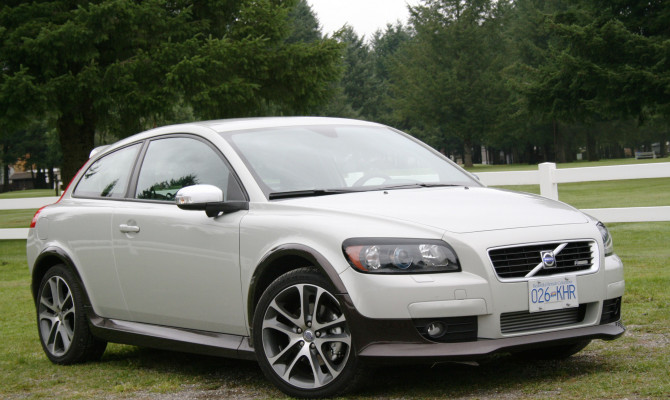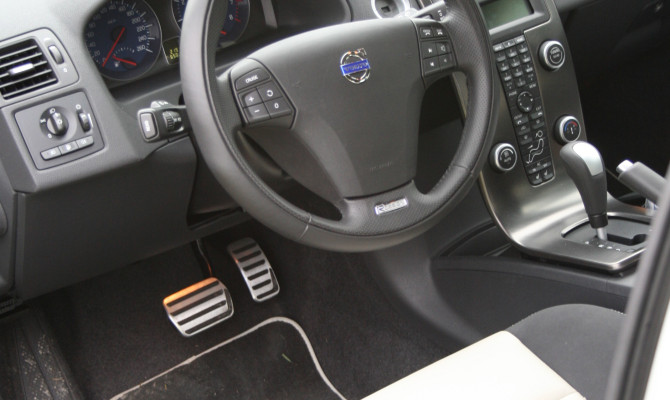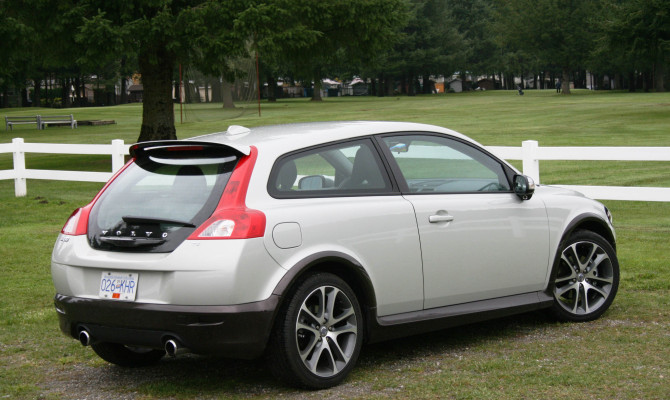“Compact yet comfortable, the Volvo C30 has a bigger car feel and a sporty, fun-to-drive disposition, yet it excels in both ride comfort and safety appointments.”
The Volvo C30 is a compact two-door hatchback that seats four people in up-level comfort.
I’m always struck by how attractive and sharp looking it can still look, when I see one on the road, even though its design dates back to 2006 and Volvo last sold the C30 in Canada in 2013. That distinctive big-glass rear hatch is a tribute to the Volvo P1800, a classic 70s era sports car.
We join the C30 story in 2009 when a mild redesign brought new standard equipment and added a new R-Design package. Heated front seats, front fog lights and an upgraded 8-speaker audio system with steering wheel-mounted controls became standard features.
A base C30 comes with a 2.4-litre, 5-cylinder engine that can produce 168-horsepower and 170 lb.-ft. of torque. It’s mated to either a 5-speed manual transmission or an optional 5-speed automatic with Geartronic (a manual shift mode). Fuel economy is rated at 11.9 L/100 km in city and 8.5 L/100 km on the highway using the new five-cycle method, but premium fuel is recommended.
WATCH: Zack Spencer review Volvo’s 2015 V60 (YouTube)
The T5 edition of the C30 comes with a turbocharged 2.5 litre, 5-cylinder engine that can produce 227-horsepower and 236 lb.-ft. of torque. A six-speed manual transmission was standard and it came with the optional 5-speed automatic with Geartronic. Fuel economy the same as the 2.4-litre.
Volvo uses a quiet, low-pressure turbocharger on the 2.5-litre engine and it’s engineered to provide good pulling power at low engine speeds. Comparing it to the 2.4L, the 2.5L can develop an addition 66 ft lbs of torque at an engine speed as low as 1500 rpm.
The side doors are extra long and allow good access to the rear seats. However, they can also be awkward to open in a tight parking stall. The rear seatbacks split 50/50 and fold to create a flat expanded load floor with 57 litres of cargo room. Even with the seatbacks up there’s still 37 litres of storage space.
The SIPS (side-impact protection) and the WHIPS (whiplash neck injury protection) are just two of the many great safety features built into a C30. Optional advanced safety systems available included a camera-based Blind Spot Information System (BLIS).
In 2010, Volvo revised C30’s trim line up and it came in Base 2.4i, Premium, R-Design, T5 Premium and T5 R-Design trim levels. The 2.4i engine editions were discontinued in 2011. It also got a styling refresh that included new fenders, trapezoidal headlights, lower front valance, and honeycomb-pattern grille with larger badge. Some small changes followed in 2012 and no changes were made for its final (2013) year in Canada.
Compact yet comfortable, the Volvo C30 has a bigger car feel and a sporty, fun-to-drive disposition, yet it excels in both ride comfort and safety appointments.
Price Check: Volvo C30 2009 – 2013 (March 2015)
Year Edition Expect to Pay Today
2009 T5 $13,000 to $16,000
2010 T5 $15,000 to $18,000
2011 T5 $17,000 to $20,000
2012 T5 $19,000 to $23,000
2013 T5 $21,000 to $25,000
*Prices vary depending on a used vehicle’s condition, mileage, usage and history. A complete mechanical check should always be performed by a reliable auto technician prior to purchase.
Safety Recalls: 2009 to 2013 with the Volvo C30
2007 to 2010 – Overheating may occur to batteries manufactured within a limited date code range. Dealers will direct customers who have an affected unit to the Garmin Web site, which explains how to verify if their units are involved and includes procedures to follow for product exchange.
2008/2009 – An improperly manufactured power steering return hose may rupture, leak fluid and cause an unexpected loss of steering power assist. Dealers will inspect and, if necessary, replace the power steering return line assembly.
2010/2011 – The gearshift lever stud assembly may not have been tightened to a correct torque setting. If the gearshift lever cable or stud assembly becomes loose, it may not be possible to engage, disengage, or shift gears. Dealers will inspect and torque the gearshift lever stud assembly to the correct specification.
2011 – A body frame member (in the engine compartment) may have been manufactured incorrectly and may have developed a crack during the forming process, reducing crash performance of the vehicle. Dealers will inspect the member and if a crack is found, Volvo will take the vehicle out of service and replace it with a new one of equal specification.
Recent Comments
- { Enjoyed your Forest of Bowland in the BMW X5M, particularly the photo of the BMW in front of the main part of Stonyhurst College where... }
- { Bantam designed the Jeep, not Willy's or Ford. The American military gave the original Bantam prototype to Willys and Ford to copy. There is plenty... }
- { All Escalades come with a 6.2-lilter V8 engine that produces 420 horsepower. A six-speed automatic is the only transmission offered and drives the rear wheels.... }
- { Alexandra is an excellent journalist. }
Popular Posts
- Journey to a ‘Sparkling’ Luxury Okanagan Resort “Four lucky readers will put a Dodge Journey’s weekend-...
- The Need For Speed: Hike Those Highway Limits More than half of those polled believe the province sho...
- Drives-U-Crazy… Erratic drivers. An early morning drive from Kelowna to Vancouver is nor...
- Readers Respond: The Pros and Cons of Increasing B.C. Speed Limits Increasing the speed limits will only increase risk to...
- Honda CR-V Review: The Compact Crossover To Get Things Done The CRV is a very stylish and aerodynamic crossover veh...









